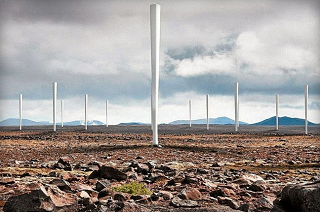Bladeless Wind Turbine

My take: I’ll be stunned if this actually has the potential to lower the levelized cost of energy (as they claim). Today’s turbines are over 80% efficient in converting the incident kinetic energy from a certain swept area into electricity. (This is incorrect; in my haste, I omitted a whole bunch of considerations here; my bad; see comments below. This should have read: …”80% of the theoretical maximum”.)
What would be an effective configuration of these devices to achieve a large swept area? How are they going to top 80%? Good luck.

Craig,
You don’t need to be a heavyweight in fluid dynamics…. You just need a little common sense. (And of course you are correct here).
😉
A current state-of-the-art wind turbine with 100-meter-span blades has a swept area of ~32,680 m2.
If instead, you were to build a bladeless tower: 2 m diameter X 120 m tall, that would have a cross-sectional area of 240 m2. The available power is directly proportional to the swept area, so a traditional turbine has an available power that is ~136 times that of a wiggling phallic tower (if I understand the concept correctly).
It’s not technically correct to say that a modern wind turbine is 80% efficient in converting the incident energy into electricity. It’s fair to say it’s 80% efficient in converting the portion of incident energy that is recovered from the wind itself might be… But that cannot be greater than 59% (Betz limit). Think of it like this: The wind hitting the swept area of the blades is going 6 m/s coming in, and is going 5 m/s going out of the turbine… So you’ve reduced the power of the wind by 42%… that fraction cannot be more than 59%, and is often less than 30%.
If we use 25% as a guide, then assume 70-80% efficiency of converting that recovered energy into electricity, we get a total efficiency of 17.5-20.0% of the energy in the swept area.
Now the wiggling phallic tower which is imagined here can indeed just flat-out stop the wind, so the Betz limit is 100%. But the incident power is ~3% of the incident power of the traditional hub, and we can generally get better efficiency from a turning motor rather than a static push against a lever (that’s why we have turbines in combustion generators rather than tubes the exhaust air can blow against). But we’ll be EXTREMELY generous and flat-out guess that this bizarre tower can achieve 40% efficiency. If so, that means that it would generate ~40% of the energy in a swept area that is 240 m2 verses a traditional hub generating 17.5% of the energy in a swept area that is ~32,680 m2.
That works out to the traditional windmill generating ~60fold what a wiggling phallic tower that is the same size as the tower traditional windmill’s tower.
(This is before factoring for the height of the average swept area, which dramatically impacts wind speed, and power is a cubic function of wind speed).
In my opinion the phallic option would have to cost less than 1% of what a traditional windmill costs which has a similar sized tower in order to make any sense.
Good analysis. Thanks. And yes, In my haste I forgot to mention the Betz limit; I’m aware of that. Rats.
But here’s why I mentioned the fluid dynamics expert: are you telling me that the wind flux that travels near (but not directly AT) the device has no effect on its shaking at all?
Not sure, but how is the energy being converted in the case of a tower? Generator type? By the way Good analysis by glenndoty01. Betz limit is important.